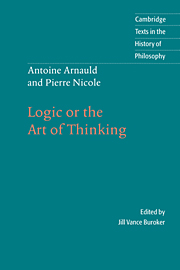Book contents
- Frontmatter
- Contents
- Acknowledgments
- Introduction
- Chronology
- Further reading
- List of works cited in the text and notes
- Note on the text and translation
- Logic or the Art of Thinking
- Preface
- Foreword
- First discourse
- Second discourse
- First part, containing reflections on ideas
- Second part of the Logic, containing reflections people have made about their judgments
- Third part of the Logic, on reasoning
- Fourth part of the Logic, on method
- Index
- Cambridge texts in the history of philosophy
First part, containing reflections on ideas
Published online by Cambridge University Press: 05 June 2012
- Frontmatter
- Contents
- Acknowledgments
- Introduction
- Chronology
- Further reading
- List of works cited in the text and notes
- Note on the text and translation
- Logic or the Art of Thinking
- Preface
- Foreword
- First discourse
- Second discourse
- First part, containing reflections on ideas
- Second part of the Logic, containing reflections people have made about their judgments
- Third part of the Logic, on reasoning
- Fourth part of the Logic, on method
- Index
- Cambridge texts in the history of philosophy
Summary
As we can have no knowledge of what is outside us except by means of the ideas in us, the reflections we can make on our ideas are perhaps the most important part of logic, since they are the foundation of everything else.
These reflections can be reduced to five headings, according to the five ways we shall consider ideas.
The first is according to their nature and origin.
The second, according to the main difference between the objects they represent.
The third, according to their simplicity or composition, where we will treat abstractions and specifications of the mind.
The fourth, according to their extension or restriction, that is, their universality, particularity, or singularity.
The fifth, according to their clearness and obscurity, or distinctness and confusion.
CHAPTER 1
Ideas according to their nature and origin
The word “idea” is one of those that are so clear that they cannot be explained by others, because none is more clear and simple. [40]
All we can do to avoid mistakes is to note the false interpretation we could give this word by restricting it merely to that form of conceiving things that consists in applying the mind to images formed in the brain, which is called imagining.
- Type
- Chapter
- Information
- Publisher: Cambridge University PressPrint publication year: 1996

